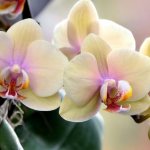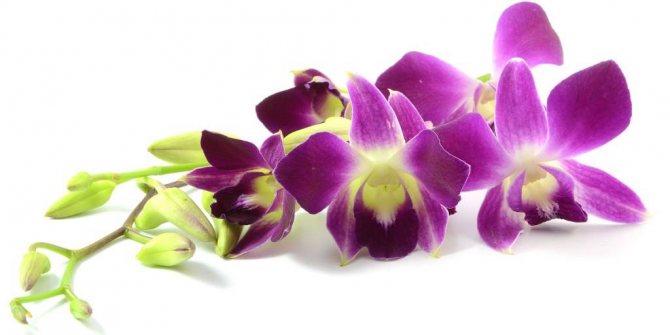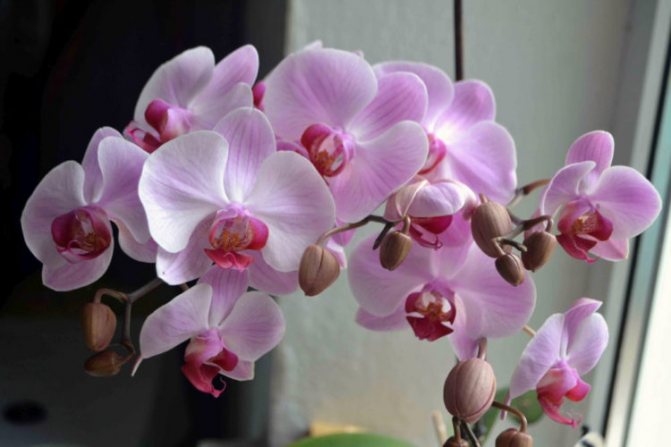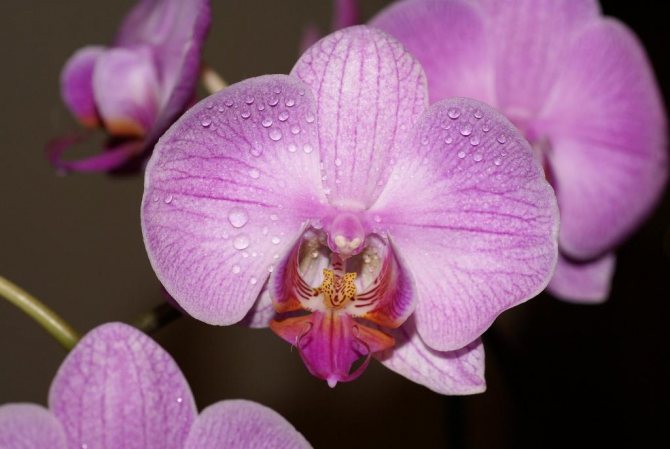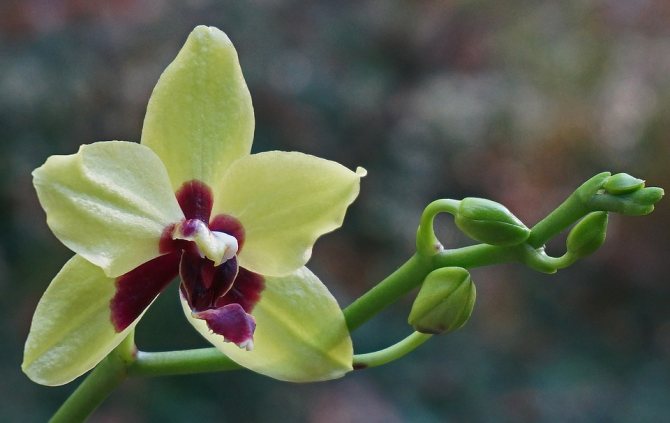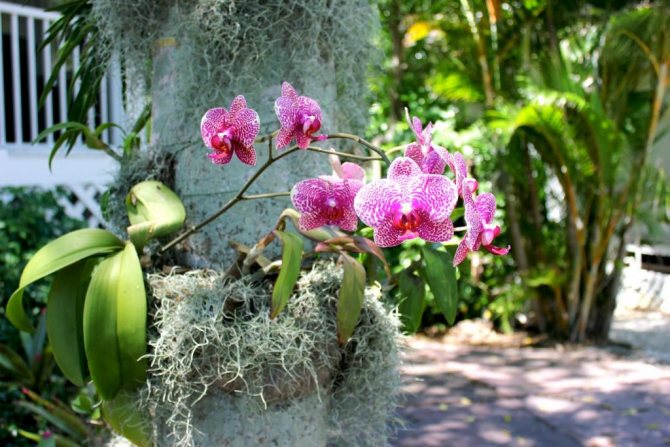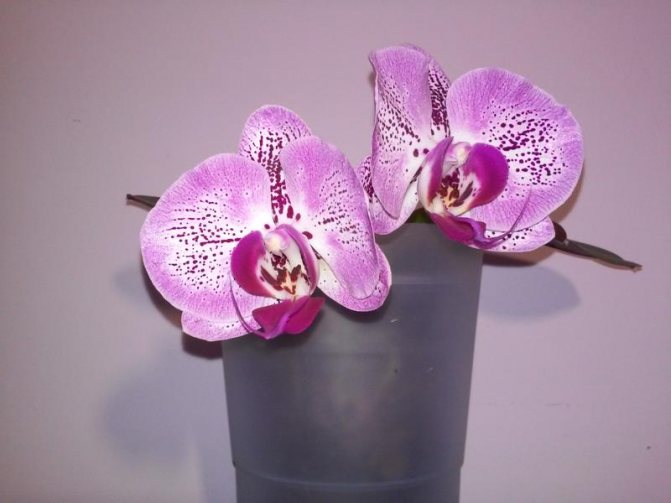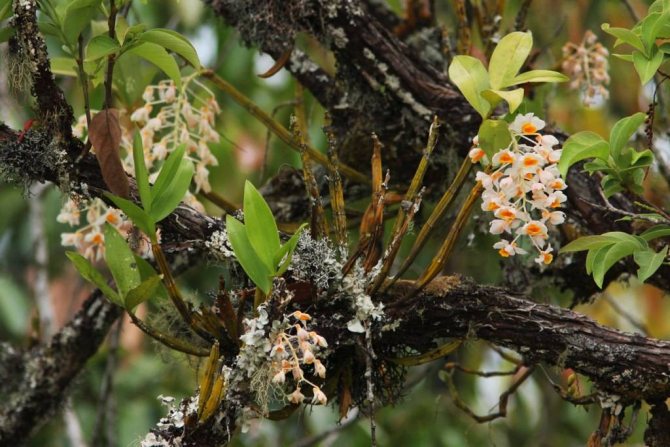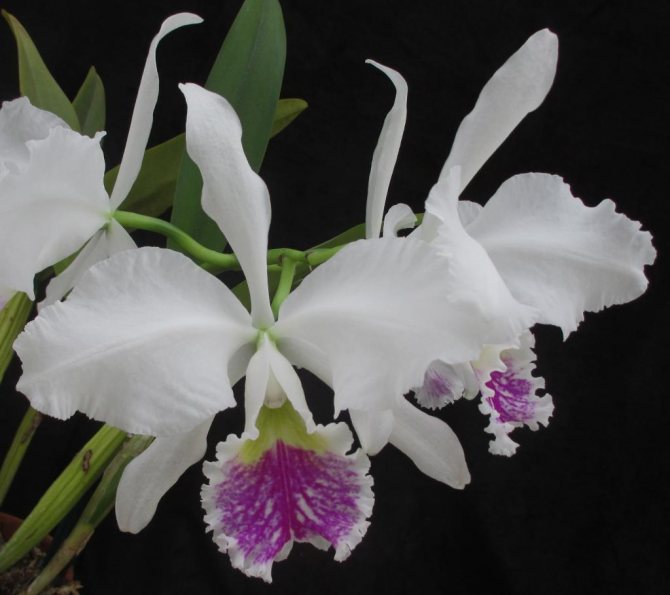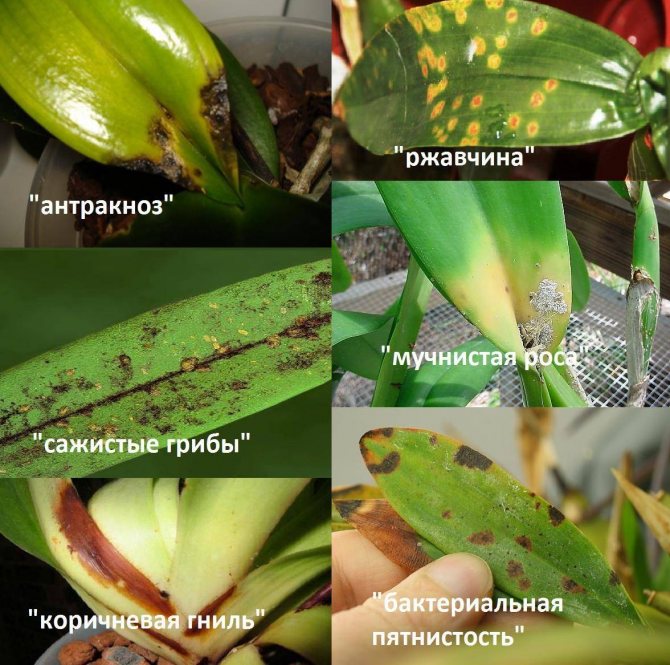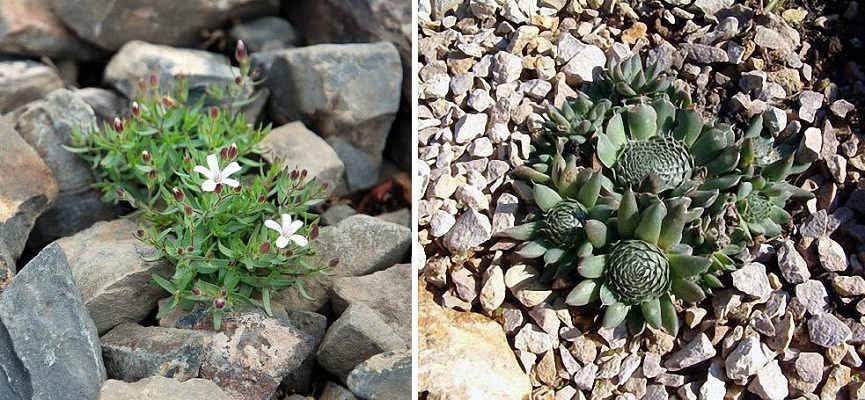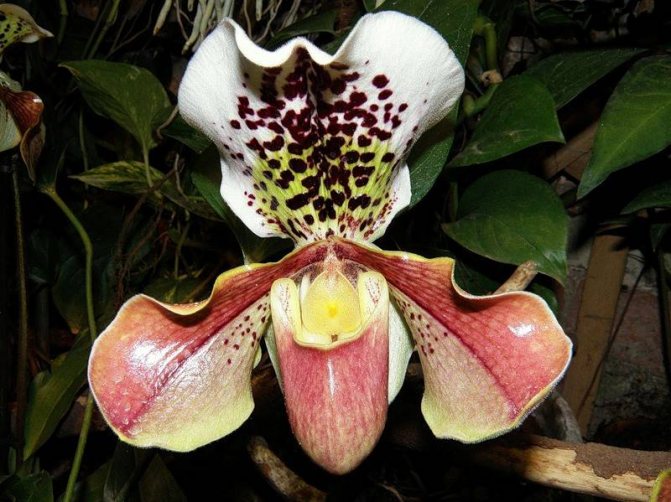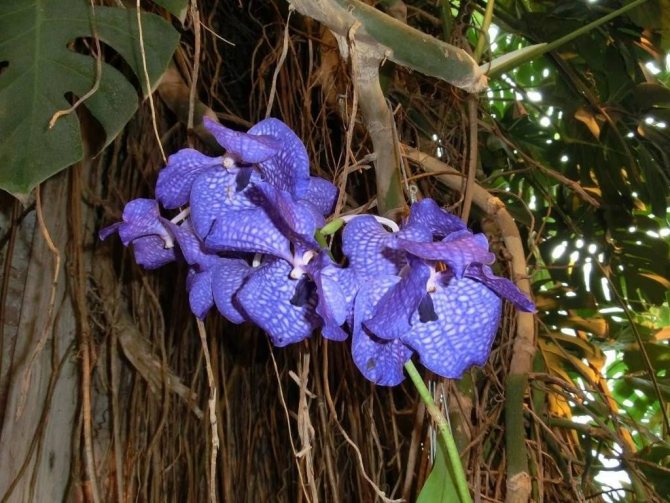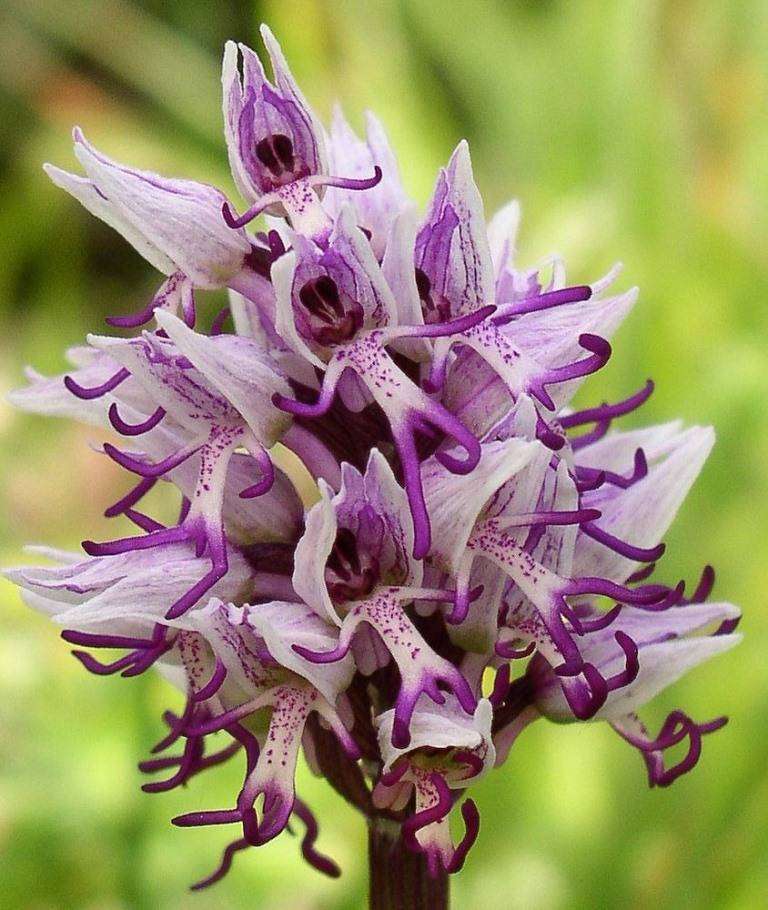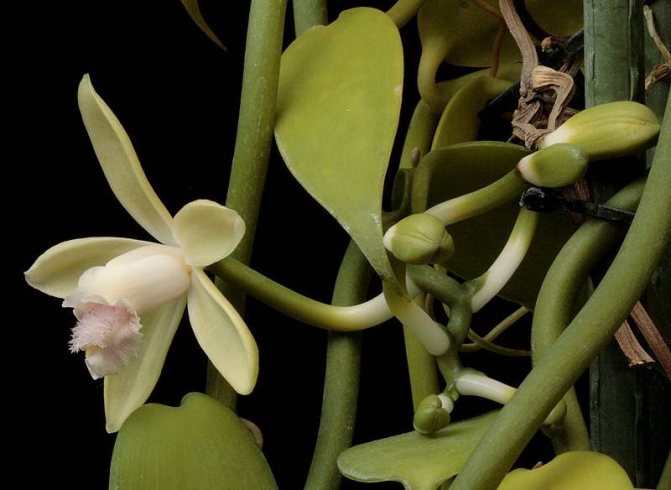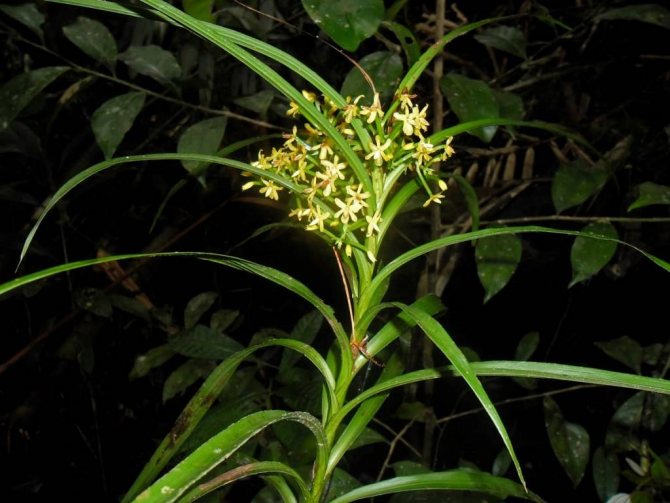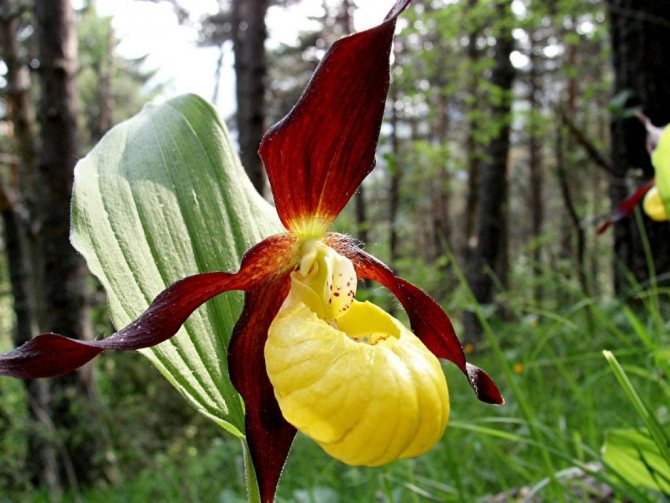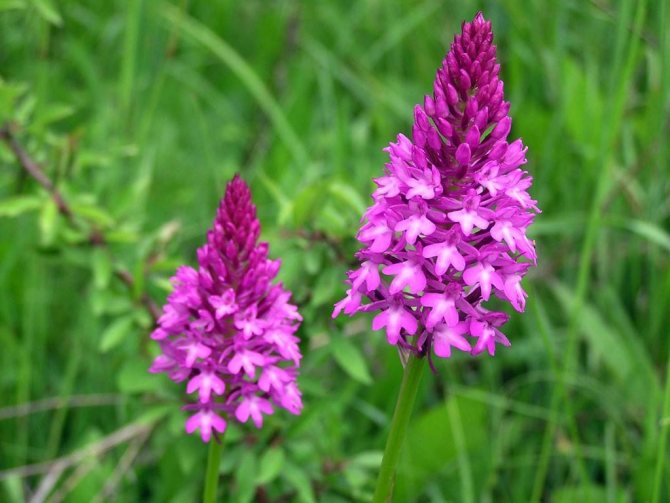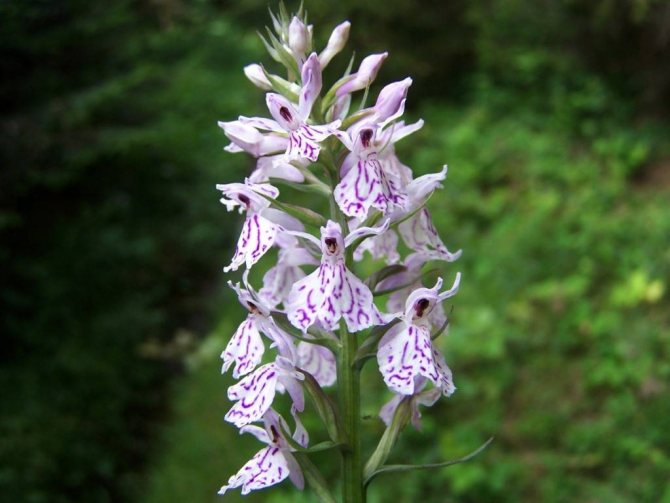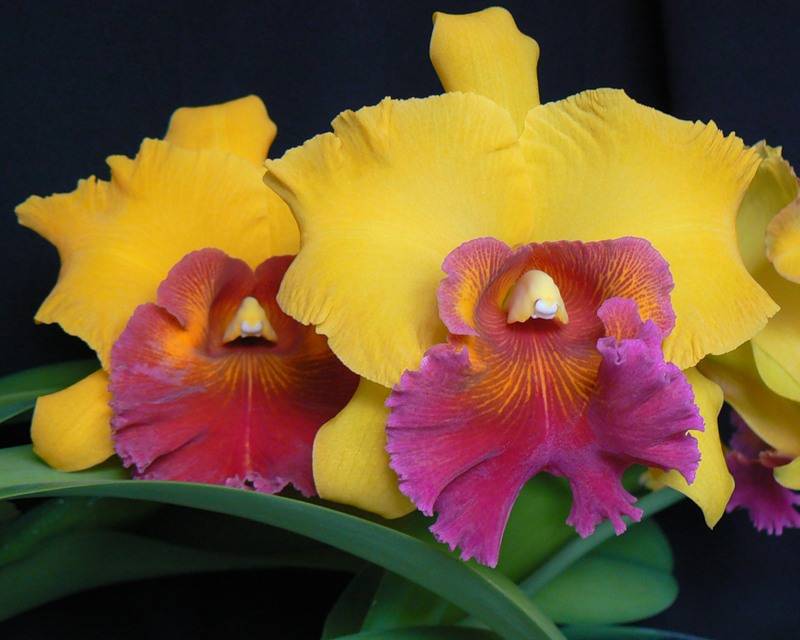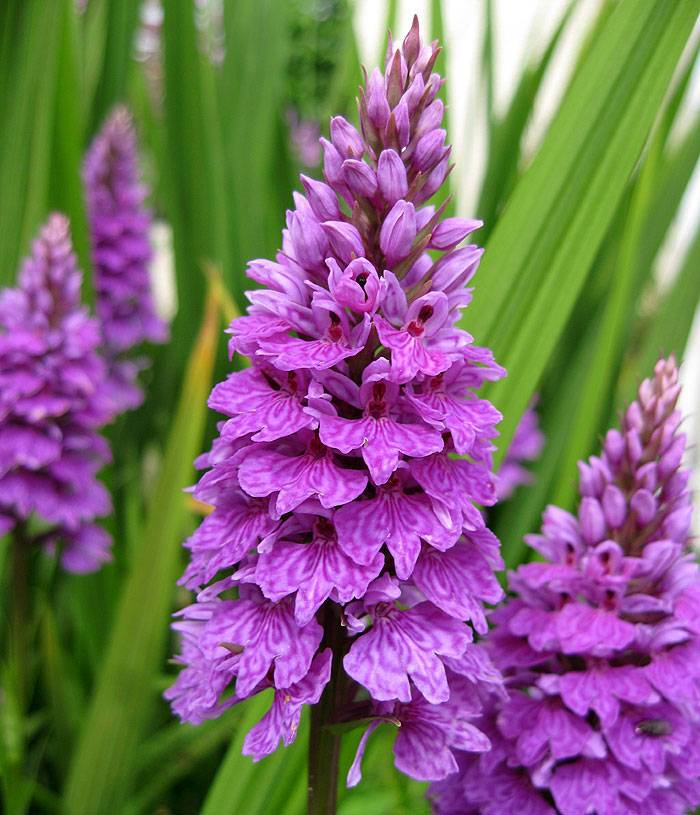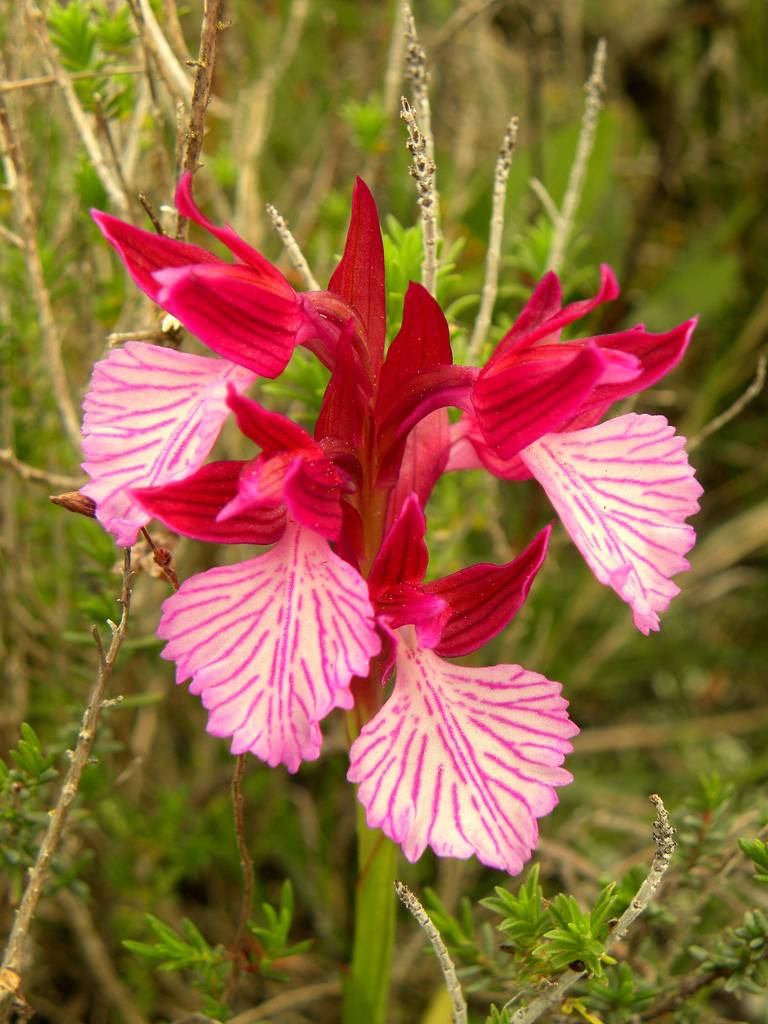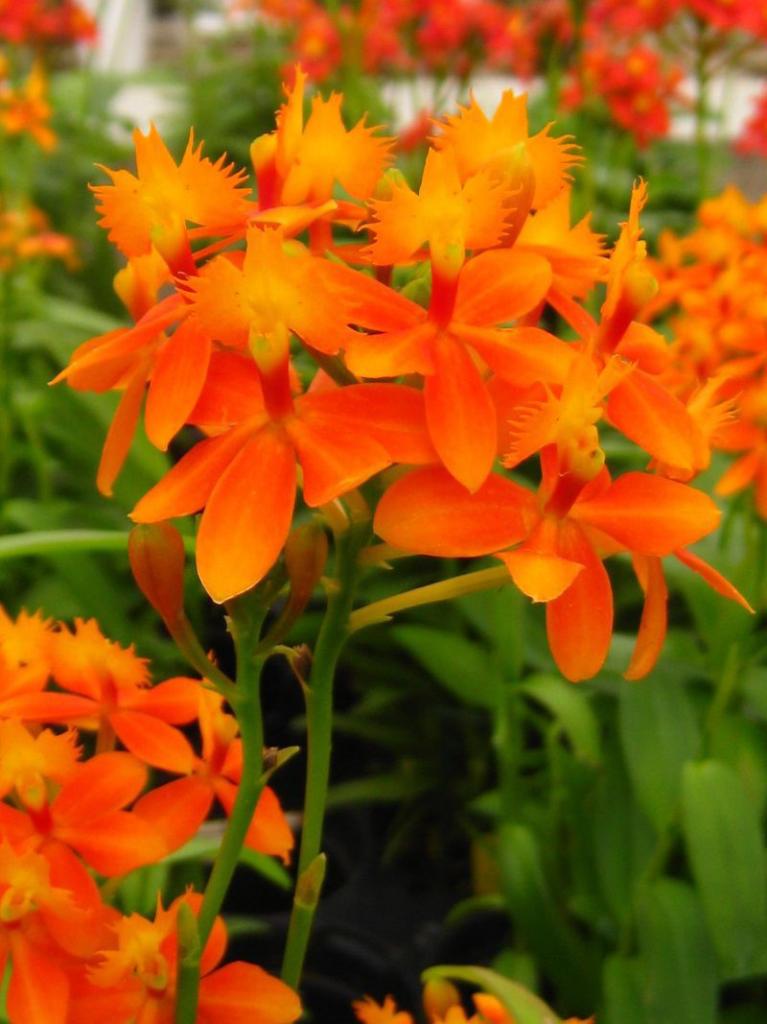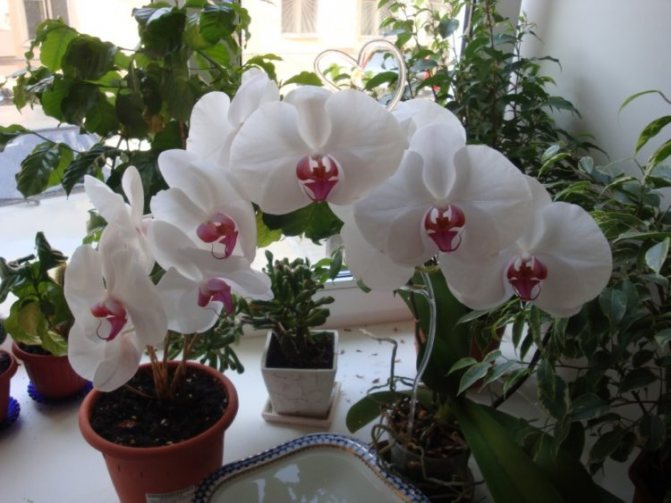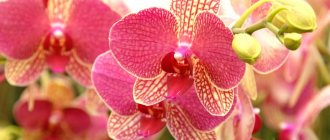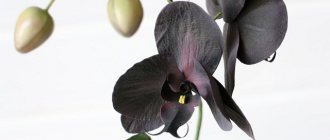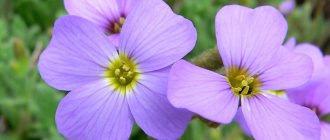Orchids Are amazing plants that can be grown in any corner of the Earth. Difficulties can arise only in the Nordic countries. At the moment, plants are widespread in the tropics. Orchids easily adapt to new conditions. For example, vines with the help of their antennae attach to trees and rise up. Flowers hang down and fill the air with a pleasant scent. But not all orchids have a pleasant smell, since there are many types of them in nature.
Of particular interest is the appearance of the orchid. Some compare them to works of art, others to swans. And the people have long taken root the name - "aristocratic flower". Orchid flowers are very complex and vary from species to species. The flowers can resemble a woman's shoe or an animal, and their size also ranges from a few millimeters to 30 centimeters. Most have three sepals at the top of the petal, which sometimes grow together. The three lower petals form the lower part of the flower. The middle petal of the lower part is also called the "lip" and it is here that the nectary is located.
In different countries, the plant is endowed with specific symbolism. For example, in China, orchids are a symbol of the beginning, spring, as they bloom before the start of the new year. According to feng shui, the orchid can be grown in all rooms, as it is a symbol of harmony. Europeans endow the flower with such traits as perfection and divine principle. In some Latin American countries, the orchid is a national symbol. This flower is also loved and revered in Russia. Here it is a symbol of love, family comfort, refinement and wisdom. Orchids are very often used as a gift for dear people (it is also customary for men to give).
Particular attention should be paid to caring for the plant. It is very important for an orchid to arrange an eternal summer, in other words - there should be enough sunlight in the room (but does not tolerate direct sunlight). Watering must be done carefully, as excess moisture will destroy the plant. It is better to filter tap water and leave it for a while, only then you can put the flowerpot with the plant in the water. If the plant does not bloom, then you need to check the correct care. Orchids do not require much maintenance as they grow in the tropics and flower buds when there is a drought.
The history of the origin of the flower
The flower received its euphonious name thanks to the ancient Greek philosopher named Theophrastus, who was a student of Plato. He discovered an unknown plant with unusual roots, which were paired bulbs. As a result, he gave the plant the name "orchis", which in Greek means "egg".
The first orchids inhabited our planet about one hundred and thirty million years ago, but widespread in China and Japan only three to four thousand years ago. In European countries, the plant has lived for two hundred years. The origin of various legends is connected with them. For example, according to one old legend, she was born from the fragments of a broken multicolored rainbow. Another myth says that a beautiful flower grew where the inimitable goddess of love Aphrodite dropped the shoe.
Where was it brought to Russia from?
Orchids to Russia were imported from Europe in the 19th century the famous Sandler firm for the king and his family. In 1894, a book was published for flower growers who grow orchids in greenhouses. There, among others, a flower is described, named after Constance Engelgard - the wife of Russia's leading orchidophilus at that time.
The second wave is considered the post-war period, when the flower was brought back from Germany, where they were taken from Goering's greenhouse. All the seedlings were transferred to the Moscow Botanical Garden.
Where do orchids grow?
Representatives of the largest family of orchids adapt so easily to habitat conditions that they have spread almost all over the globe and feel comfortable in absolutely all climatic zones, except for the harsh Antarctica. The main part of orchid species grows in the tropics, but these luxuriously flowering plants can be found in latitudes with a temperate climate. Europe and Asia, the countries of North and South America - anywhere orchids perfectly adapt to natural conditions, bloom profusely and increase their range.
Appearance in Europe
Orchid plants were introduced in the European part of the earth in the 18th century. This was due to the discovery of new continents and islands. And from there they began to import exotic plants, including orchid flowers.
There is even a legend that a botanist in England received a practically dried orchid bulb as a gift. But with his good care, she came to life and sprouted. This gave impetus to the development of the orchid in England, and then in Europe.
This tropical flower was popular with florists. and exported in large quantities from their homeland. Since they could not propagate it with the help of seeds, and the division of the bush was not always successful.
Description
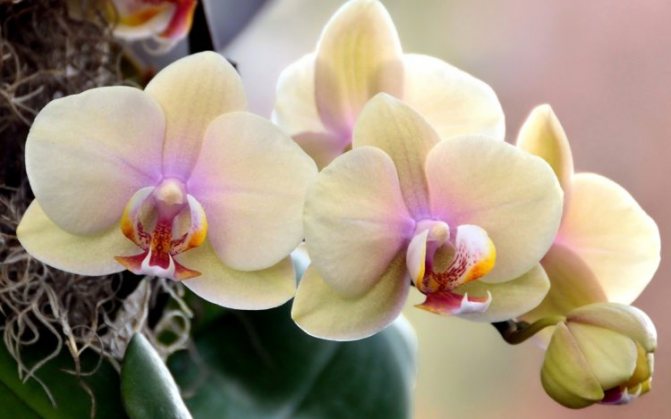
Orchid (Orchids, as well as Orchids) is a plant of the flowering department, of the monocotyledonous class, of the order of asparagus, of the orchid family. Orchids are one of the richest species of plant families.
The orchid plant acquired its name in ancient Greece thanks to the philosopher Theophrastus, a student of Plato. As a result of scientific research, the scientist came across an unfamiliar flower with roots in the form of a paired bulb and gave it the name "orchis", which means "egg" in Greek.
Orchid flowers make up one of the most numerous plant families, the main part of which in nature is perennial grasses. Shrub form and woody lianas are less common. Orchids can range in size from a few centimeters, although individual species grow up to 35 meters in height.
Most of the orchids are epiphytes that grow on other plants, using them as a support and are not parasites at the same time. Epiphytic orchid flowers do not depend on the soil, receive more light and suffer less from herbivores.
The roots of the epiphyte orchid are extremely important organs as they perform many essential functions. First, with their help, orchids are attached to the substrate, which allows them to maintain an upright position. Secondly, the roots are actively involved in photosynthesis, sharing this function with the leaves. Thirdly, with the help of the root system, orchid flowers absorb moisture and nutrients from the air and bark of the plants on which they live.
Another, smaller part of orchids are lithophytes growing on rocky and stony rocks. Terrestrial orchids make up the medium-sized group. Both types are endowed with underground rhizomes or tubers.
The green stem of an orchid can be long or short, creeping or erect. Leaves are simple, alternate, on each plant there may be one or more of them. Orchid flowers of the most varied colors and sizes form 2 types of inflorescences: a simple spike with a single arrangement of flowers or a simple brush with several flowers on pedicels growing along the stem.
The orchid flower belongs to insect pollinated plants, and the mechanisms of pollination of each species are sometimes unusual and very diverse.Orchids-shoes, which have a "shoe-like" flower structure, are endowed with a special trap for pollinating insects.
Orchis have sticky legs, the flowers of this orchid mimic the smell of female bees, thereby attracting males. Flowers of tropical orchids intoxicate insects with an unusual aroma, other species shoot pollen towards the pollinating insect. The orchid fruit is a dry capsule containing up to 4 million microscopic seeds, which is a kind of productivity record among flowering plants.
The life span of orchids in natural conditions is individual, depends on many factors and under favorable conditions can be 100 years. In greenhouse conditions, many types of orchids live up to 70 years.
The tropics in your home
If you decide to acquire such a wonderful flower at home, you should take care of creating a climate similar to it. The homeland of the room orchid is rich in warmth, light and moisture. The air temperature should be within 20-25 degrees. If the air temperature drops, the plant may not bloom at the right time or even get sick. Orchids are delicate plants, and blooming takes a lot of their energy. If the plant is weakened, and the peduncle has already been thrown away, then it is better to cut it off.
The flower is photophilous, but the direct rays of the sun will be detrimental to it. In winter, it is better to place the plant on the southern side of the apartment, and with the onset of summer, move it to the eastern or western zone. When daylight hours are shortened, you will need to provide the flower with an additional source of light. For these purposes, you can use a fluorescent lamp. Place it at some distance from the plant, orchids - at least 11 hours a day.
Orchid species


The modern classification of orchids, developed by the American scientist Dressler, contains 5 subfamilies, each of which is subdivided into several genera and many species:
- apostasy (Latin Apostasioideae) is a primitive subfamily consisting of 2 genera: neuvidia (Latin Neuwiedia) and apostasy (Latin Apostasia) and 16 species of orchids, which are small herbaceous perennials. These orchids grow in Australia, New Guinea, Indochina and Japan.
- cypripedia(Latin Cypripedioideae) - represent 5 genera and 130 species of orchids, consisting of terrestrial, rocky and epiphytic perennial grasses. One of the well-known genera is the Lady's Slipper, 5 varieties of which are found in Russia. The range of the subfamily is distributed over the temperate, tropical and subtropical latitudes of all continents, except Africa.
- vanilla (Latin Vanilloideae) - the subfamily includes 15 genera containing 180 species of orchids. Herbaceous plants or vines are distinguished by a large number of flowers in the inflorescence. Fruits of representatives of the genus Vanilla (Latin Vanilla planifolia) contain vanillin, which is widely used as a spice, perfumery and pharmacology. These orchids grow in the tropics of the African continent, Central, South America and Asian countries.
- epidendric (lat. Epidendroideae) - the largest subfamily consists of more than 500 genera, forming over 20 thousand species of orchids. They are epiphytic perennials, less often terrestrial grasses, extremely rarely vines. Dactylostalix (Latin Dactylostalix), listed in the Red Book of Russia, is considered a remarkable genus. And also the genus Cattleya (lat. Cattleya), distinguished by fragrant, large, exceptionally beautiful inflorescences. These orchids grow in the temperate, tropical and subtropical zones of all continents.
- orchids (orchids) (Latin Orchidoideae) - the subfamily unites 208 genera and almost 4 thousand species of perennial terrestrial plants with an erect stem. The genus of orchids Anacamptis (Latin Anacamptis) with beautiful spike-shaped inflorescences of bright color is considered interesting.And also representatives of the genus Palchatokorennik or Dactyloriza (Latin Dactylorhiza), the dried roots of which are used in case of poisoning and as a nutritional component in depletion. These orchids are found on all continents except Antarctica. The genus Phalaenopsis is also very common; it is the representatives of this genus that are widely cultivated at home.
What kind of lighting does an orchid flower like?
Every florist needs to know what kind of lighting orchids love. Most plants, and orchids are no exception, need light for photosynthesis. Each kind of orchid requires a different amount of light, because in nature they all live in different climates. Some species prefer full, bright sun, while others like deep shade under tree canopy. Mountain orchids, for example, require a lot of light, but not direct, but diffused. Leaf burns and pseudobulbs can permanently stop growth and even kill the plant. On hot sunny days, shading (tulle, gauze) is recommended. Each orchid grower needs to know exactly what type of orchid is in his home in order to provide him with the required amount of light, which is very important for the onset and flow of the flowering process.
When caring for an orchid at home, lighting is of paramount importance. For practical purposes, three groups of plants are usually distinguished according to their needs for light intensity: orchids, which require an abundance of sunlight; flowers requiring moderate light; the least light-loving plants.
Orchid varieties
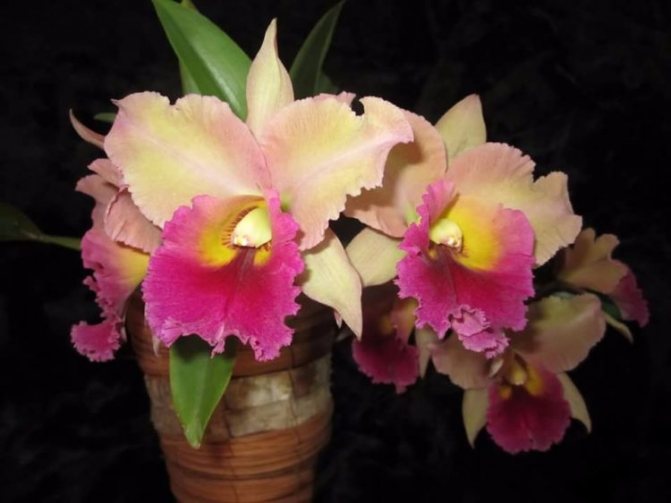

There are endless varieties and varieties of orchids, among which the following can be distinguished:
- Cattleya labiata (lat.Cattleya labiata).One of the largest representatives of cultivated orchids, although there are also small cattleyas. This variety has a very beautiful flower with wax-coated petals and a corrugated lip. The color of the orchid flower, which “lives” for almost three weeks, is the most versatile - from pale pink and beige tones to deep purple.
- Cymbidium Orchid(lat.Cymbidium). An excellent variety of orchids, resistant to stress and unpretentious to care for. Hanging stalks contain 10-13 orchid flowers of the most unimaginable palette - from boiling white to purple or bright orange. This orchid variety blooms profusely and continuously for 8-10 weeks.
- Fragrant lycast "Gold" (lat.Lycaste aromatica). This orchid variety is loved by connoisseurs for its spectacular bright lemon-toned flowers with a delicate and persistent aroma. Peduncles are high, up to 25 cm, flowers in diameter often exceed 15-17 cm.
- Darwinar's Orchid(lat.Darwinara). A miniature hybrid of an orchid with very dark, leathery leaves and a graceful inflorescence, including small, 2-3 cm in diameter, blue-violet flowers. The inflorescence is racemose, may contain 7-12 flowers with a delicate aroma.
- Potinara "BuranaBeauty "(lat. Potinara Burana Beauty). The hybrid is distinguished by luxurious variegated yellow-red flowers, with wavy petals. The peduncle of an orchid of medium height, this orchid variety blooms all summer, and with proper care it pleases with beauty even in the first autumn month.
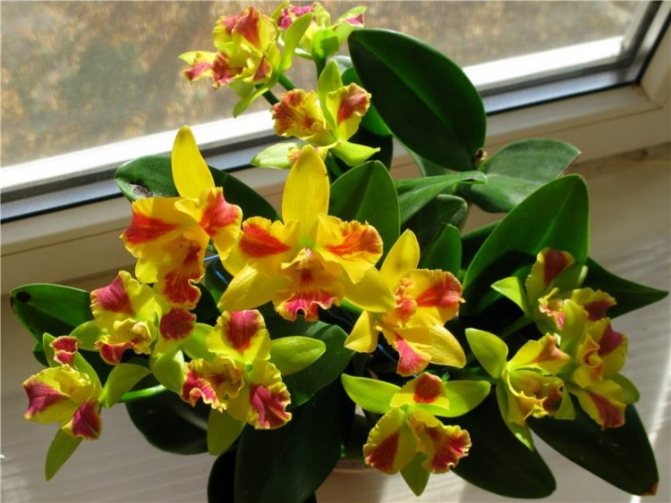

- Cymbidium "Twelve" (Latin Cymbidium Twelve).An orchid with long, rather narrow leaves. The cymbidium "Twelve" orchid bud is whitish-pink in color, with a slight reddish speck. Inflorescences drooping, racemose, short.
- Orchid Dendrobium Nobile (Latin Dendrobium nobile)sometimes reaches 60 centimeters in height, the minimum growth of this individual is about 30 centimeters. The diameter of one bloom varies from 4 to 7 centimeters. And the branch of the Dendrobium Nobile orchid can have inflorescences of different tones.
Phalaenopsis
Phalaenopsis is the most undemanding orchid to care for. It was she who allowed professional flower growers to take a decisive step forward, and deservedly took one of the most prestigious positions in many greenhouses. Homeland - northeastern Australia, the Philippines and southeast Asia.
Plants have huge flowers that look like moths. Their colors can be very different, and the flower seems to be made of wax. Phalaenopsis does not require special humidity and temperature extremes. It is hardy, blooms twice a year, and its flowers do not fade for several months.Phalaenopsis have another unusual feature. They can form processes - babies in the axils of the peduncles. When such an outgrowth sprouts, it can be separated and transplanted into a separate substrate.
Planting orchids at home
Surprisingly, contrary to popular belief that an indoor flower should grow in a pot with soil, orchids prefer to "dwell" in containers with a substrate of bark, sand, forest moss, peat and even foam. Orchid soil can be bought ready-made, or you can make it yourself.
Pine bark is usually taken from a “dead” tree. It is crushed, boiled in water and dried. In moss, only the upper green part is used, after washing it with boiling water and grinding it. The sand for the substrate is only coarse. You can also add charcoal, foam chips and small expanded clay to the mixture. The components are mixed and thoroughly moistened immediately before planting the orchid.
By the way, when choosing a pot for an orchid, stop at pots made of white or other light plastic: they will bask less in the sun. Wicker baskets or pots are perfect for planting orchids. You need to plant the plant as carefully as possible so as not to damage the rather fragile roots of the orchid. You should not tamp the substrate - just fill them in the voids around the rhizome of the flower.
Why isn't the orchid blooming?
In any case, this beauty refuses to bloom because of the poor conditions of its detention. The absence of flowers can be caused by excessively dry or very humid air, the temperature of the flower content below 22-25 degrees, lack of sunlight, or, on the contrary, too "hot and sunny" windowsill.
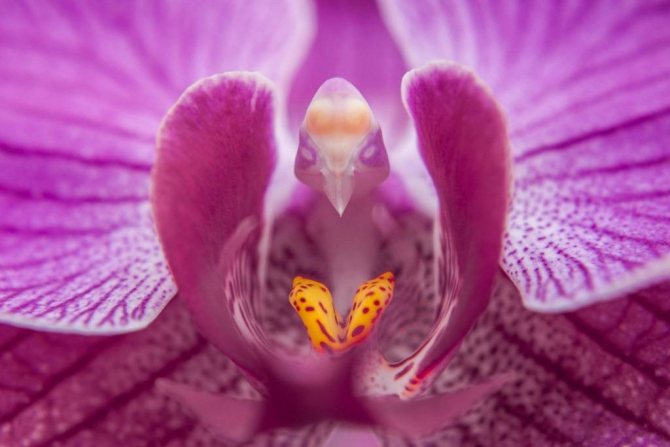

Phalaenopsis orchid flower
Plant care
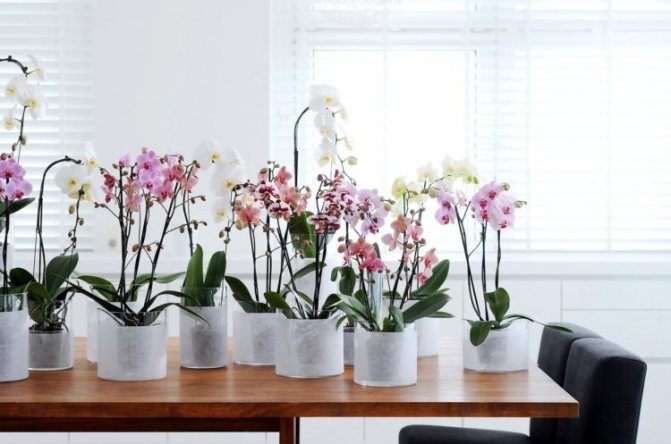

To maintain a comfortable environment for good growth and flowering of the orchid, it is important to keep track of:
- ensuring good lighting;
- for proper watering;
- for choosing a suitable soil;
- for the timely transplantation and feeding of the plant.
Each of these conditions is very important for the proper maintenance of this exquisite plant.
Necessary lighting
Adequate supply of light is the determining factor in the emergence of new flowers and the maintenance of the duration of flowering. Provided that the light of the orchid is not enough, then the optimal growing cycle will be disrupted. With too much light, the orchid burns out. The characteristic signs of insufficient light supply are the appearance of darkish spots on the leaves of the plant. The yellowness of the leaves and brown spots on them indicate that the lighting is excessive.
When choosing a place where this plant will grow, you should avoid windowsills on the sunny side. A glazed loggia facing west or east is considered an ideal place for good flowering of an orchid. The loggia on the south side to keep the plant will have to be darkened with special curtains, and on the north side of the room the plant will not bloom and may even die.
Proper watering
Experts are sure that the orchid begins to die due to the appearance of stagnation of moisture in the soil, as well as due to the effect on its roots of salts dissolved in the irrigation liquid. It should be noted that this potted plant tolerates drying out of the soil better than its excessive moisture.
The following factors usually affect the frequency of watering:
- average room temperature;
- air humidity;
- the frequency of the sun's rays;
- the size of the flower pot;
- growing season.
To determine the frequency of soil moisture, it is worth considering each of the listed factors. Lack of moisture contributes to the appearance of pseudobulbs and dry leaves. With excessive moisture, the process of decay of the roots of the orchid begins, which soon affects the condition of the plant as a whole.As experts recommend watering: Place the pot with the plant in a small container of water at room temperature for a quarter of an hour. Place the plant in the bathroom and water it vigorously using lukewarm water and a shower. Make sure that the substrate is completely wet and that excess water comes out of the special holes in the bottom of the pot. Using both methods, after watering, the pot must be placed on a small grate and the excess moisture must be allowed to drain completely.
Soil selection
An exquisite beauty orchid needs a fairly light substrate that does not at all resemble the fertile soil necessary for other plants. It should include: crushed pieces of wood bark and coal, small clay granules, small cork particles, sand, forest moss, special plant components, perlite or vermiculite. For plants that take root in the ground, pieces of dry tree leaves are added to the soil.
Timely transplant and feeding
The flower is transplanted no more than 1 time in 2 years. During active growth and the appearance of flowers, the orchid needs feeding. You need to feed the plant with a specially developed fertilizer and this must be done no more than 1 time in 14 days. While watching the video, you will learn about the reproduction of orchids. Taking into account the listed rules for caring for orchids, the owners of this wonderful plant will enjoy for a long time its flowering on their windowsill.
Substrates for growing orchid flowers
During active growth, orchids are recommended to be fed with a weak solution of mineral fertilizers. The easiest way to do this is to use a complex mineral fertilizer. Top dressing is carried out every 10-15 days very carefully, for epiphytic species - in a weaker concentration.
Epiphytic orchids are grown in baskets or perforated pots and bowls. A common substrate for growing orchids is a mixture of crushed fern roots and sphagnum moss in a 2: 1 ratio with the addition of pieces of charcoal.
Orchids can also be grown on crushed pieces of pine or spruce bark, or on a 1: 1: 0.5 mixture of bark, broken shards and charcoal. Many orchids grow successfully on blocks of pine, cork, or regular oak bark. Terrestrial orchids are grown on a mixture of leafy soil, peat, humus and river sand; some species - on a looser mixture of rotted leaves and fibrous peat. In all cases, charcoal and broken shards are added as a baking powder.
Sphagnum moss - one of the most classic substrates since ancient times. An irreplaceable component of any mixtures for growing both terrestrial and epiphytic orchids. Has a disinfecting effect, which is indispensable for young plants, in the "resuscitation" of orchids affected by pests or diseases, vegetative reproduction. The substrate can be covered on top with a 1–1.5 cm layer of sphagnum.


Osmunda roots. It is one of the most popular orchid growing media. It consists of peeled and washed osmunda fern roots (mainly used by Osmunda cinnamomea and Osmunda claytonia), which are very wire-like. They are able to hold a large volume of water and perfectly retain their properties for a long time.


Coconut. Recently, this product has become the # 1 hit in the orchid world. Someone was the first to notice that a coconut can swim in the ocean for a long time, and once it reaches the shore, it begins to sprout. This means there is a great substrate inside the coconut. When growing orchids, its inner part is used in the form of small pieces - fractions (they are called chips), as well as long fibers - orchids are tied up with them. From contact with water, the fractions do not become heavy, but their most amazing feature is that before and after contact with water, they pass the same amount of air.Fibers also hold water just like chips. The outer layer of the chips dries up, while the inner layer remains moist. This product is very durable: it will take at least 5 years before the chips begin to break.
Expanded clay and broken terracotta clay - structured, durable, affordable, moisture-consuming (terracotta - 15–25%, expanded clay - 40% and more). But in terracotta and majolica clays, lime and dolomite are often used as additives. Water after contact with expanded clay, as a rule, gives an alkaline reaction and has a fair amount of hardness. Such substrates are very prone to salinization.
How to propagate an orchid?
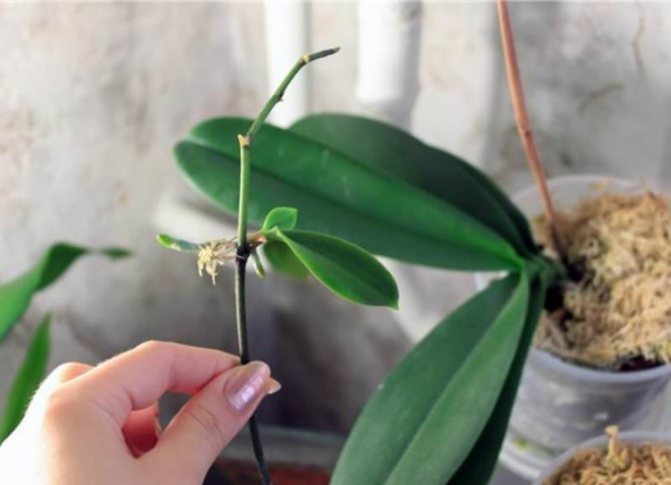

There are two ways how the Phalaenopsis orchid will propagate at home: vegetative and their seeds.
Vegetative propagation
When lateral processes appear, they can be deposited if they have begun to develop their own roots. Sometimes young babies emerge from knots on the peduncle. If the plant you are replanting is too tall and has good roots, you can divide it up, leaving a stump with several roots. Often a young orchid begins to develop at the top of the old part. When she gets stronger, she can be planted. When a Phalaenopsis orchid is propagated at home, a young baby of any type should be planted in sphagnum or soft osmund fibers, and then covered with plastic wrap along with the pot to create moist air. Very rarely, babies develop on the roots.
Growing from seeds
Pollination is carried out in the same way as in other genera. The pods ripen quickly, 5–6 months after pollination. A ripe pod dries up and opens rather suddenly, so it is best to cover it to avoid shedding the seeds. Seeds lose their germination rather quickly, although they can be stored in the refrigerator for a short time. They are also more sensitive to disinfectants than other varieties.
Calcium hypochlorite is the most harmless remedy, but seeds should not remain in its solution for more than a day. It is best to sow seeds from a green pod. Remove the pod at least one month before normal opening; the best time is considered to be 4–4.5 months after pollination. Seedlings grow quickly and are ready to be transplanted from flasks at about 6 months. They can be transplanted into boxes or common bowls. Then they should be covered with glass to create a warm, stuffy atmosphere. When ready for custom planting, use 10cm pots. Phalaenopsis bloom at about three years, sometimes even earlier….
Problems and features of growing orchids
If the orchid does not bloom, the reason may be a lack of light, an excess of fertilizer, or the temperature regime is not suitable for it. It must be borne in mind that young plants under 5 years old do not bloom. If the leaves of an orchid have darkened, this may be due to improper watering or excessive feeding. If a white cotton bloom appears on the leaves, a mealybug may be the cause. Small dark round spots on orchid flowers are a sign of a fungal disease. From the excess of the sun, the leaves of the orchid will turn unusually green. Holes in the tips of the leaves indicate that you have snails in your house. But if the leaves are shriveled, this is a sign of a viral disease. It is better to get rid of this orchid.
Another common problem is root rot, which manifests itself in plant lethargy, leaf drooping, softening of the root collar, can be caused by excessive watering, watering with cold water, planting too deeply, damage to the roots during transplantation. If for any reason orchids lose roots, it is imperative to preserve those of them, albeit bad ones, that still remain.To do this, you need to cook sphagnum, scald it, cool it, squeeze it, pour it with a complete mineral fertilizer (for example, Kemira Lux) with a concentration of 0.5 g / l, squeeze it out, keep it in a closed plastic bag for three days. After that, the sphagnum is ready for use. Then you need to lay the plants on top of the prepared sphagnum and create greenhouse conditions for sick plants with available means (greenhouse, aquarium, plastic bag, glass jar) with mandatory supplementary lighting in winter. The temperature during orchid regeneration should be close to optimal - 25-27 ° C.
The lack of flowering can primarily be caused by non-observance of the peculiarities of growing orchids, for example, an incorrectly conducted dormant period, lack of lighting, too dry indoor air, etc., and is also observed when diseases and pests are damaged, with an incorrect transplant or planting in an unsuitable soil mixture.
Some types of orchids can only be grown in small greenhouses with additional lighting and a certain temperature regime.
Orchid diseases


- The spider mite is a real misfortune for our phalaenopsis. A hot shower, spraying with various acaricides will help here, phytoverm is the most harmless. 3 - 4 treatments are required at intervals of a week.
- Festering is formed in the axils of the leaves, in the roots and on the peduncle, if the flower is supercooled and receives a lot of liquid. Transplant the orchid immediately, change the substrate to fresh, reduce watering. Move the pot to a lighter, warmer place. If you find root decay, cut out all decayed roots with a knife. It is recommended to sprinkle with cinnamon and grease with foundation. To prevent the orchid from pests and diseases, it is better to place the pots on trellises so that the infection does not spread when watering. It is important to decontaminate pots and tools when planting and breeding. Copper sulfate is usually used for disinfection.
Moderate watering
Watering the plant in summer is necessary once every 3-7 days, in winter - no more than once a week. The ground should not be wet all the time. In the interval between watering, it should dry out properly. The homeland of the orchid sometimes changes from torrential rains to drought. It is during periods of stagnation that insects fly to pollinate the flowers, and the orchid prepares for this in advance. If we water less often, the plant will start planning flowering.
Watering can be combined with top dressing, 1-2 times a month is enough. For fertilization, special complexes for orchids are used. When watering, make sure that water does not fall on the axils of the leaves and the growth point. If this happens, remove the water with a cotton swab.
When watering, the substrate in which your orchid grows should be well moistened. Pour water well around the pot; excess water should drain completely into the pan under the pot. We drain it from the pallet and repeat the watering again.
Prevention of various problems
How to prevent orchid diseases:
- The leaves became yellowish, lost their bright, rich green color - weaken watering, adjust the humidity of the air, shade the windows.
- If the leaves begin to fall, then the humidity is insufficient, you have dried out the air. And, perhaps, the substrate also receives less moisture. Spraying is required, additional watering.
- Leaves rot - this is a sign of improper care. Make sure that the leaves, sinuses, the outlet do not get wet, and if they get wet, they must be carefully wiped with a dry cloth or dried with a hairdryer.
Life-giving moisture
Wet forests are the birthplace of the orchid. The room darling in your home will lack air humidity. To organize her optimal living conditions, place her near the aquarium or simply place a bowl of water. As the water evaporates, the flower will receive life-giving moisture from the air. The plant must be moistened with water from a sprayer, but so as not to wet the flowers.Water should be used distilled or boiled, it should be soft, warm and moderately hard. Water plays an important role in the life of an orchid, it is not only a means of nutrition, but also a temperature regulator.
Orchid: beneficial properties. The use of orchids.
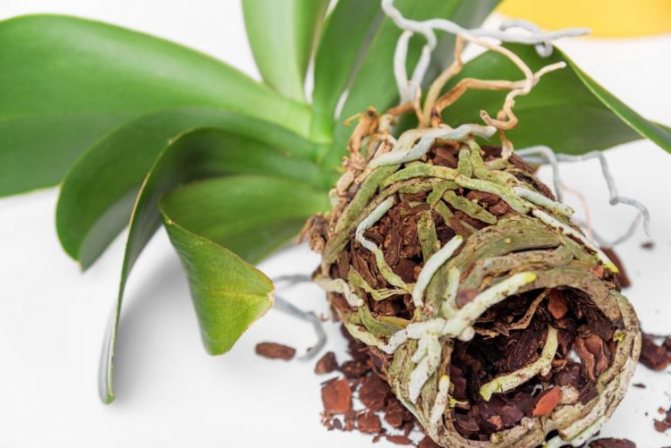

In addition to exceptional decorative properties, some types of orchids have valuable beneficial properties that are widely used in folk and traditional medicine.
Tubers of certain orchid species contain a large amount of mucus, rich in antiseptics and immunoglobulins, as well as starch and protein. A decoction of the roots of Lyubka two-leaved is used for indigestion, inflammation of the bladder, as an analgesic and antiseptic.
The roots of the Kremastra orchid are used as a pain reliever and as an antidote for snake bites. Dendrobium nobile or noble is used for gastrointestinal diseases, pain syndromes and as an aphrodisiac. Three-fold or triple calantha is used to treat diarrhea, relieve swelling and all kinds of pain. Anectochilus royal is a rare epiphytic orchid, from which valuable medicinal oils are obtained.
Meet the royal family
An important role for orchids in Europe was played by the acquaintance with the royal family, from which the fashion of collecting the plant appeared. Princess Augusta, mother of King George III, founded the Royal Botanic Gardens in Kew, where orchids grew under the care of Joseph Banks. The first catalog of these plants was compiled by Royal Botanic gardeners William Ayton and his son in 1974.
Admiral William Blay donated fifteen orchids from East India to the garden. Collecting orchids has become fashionable among wealthy amateur gardeners. This plant has become a kind of confirmation of its status in high society.
Some species were put up for auction and the Rothschild dynasty and the Russian royal family competed for the purchase.
Key facts


- The name of the genus comes from the Greek. phalaina - moth, moth, opsis - similarity.
Orchids can be grown in the back of the room under artificial lighting. But wherever the flower stands, it needs 12-hour daylight hours.
- From domestic fluorescent lamps for illumination of phalaenopsis, "LD" or "LDC", giving white light, are suitable.
- The roots of the flower are capable of photosynthesis, and in places illuminated by sunlight, they are colored green by chlorophyll.
- Plants blooming in winter require more watering than non-blooming plants. For their normal development, it is necessary that the root system does not overcool.
- Planting small specimens and children differs only in the size of the substrate particles. In the lower part of the pot, above the drain, you can use a fraction up to 1.5 cm, the rest of the bark should be no more than 1 cm.
In the large bark, babies and small specimens develop poorly.
- In an orchid, the roots on the surface of the substrate, due to low humidity, often have a shriveled, unviable appearance, but this is not a cause for concern.
- If it is not possible to give the plant backlight in the winter, you can transfer it to spring-summer flowering, and arrange a rest in winter.
- For planting phalaenopsis babies, you can use pure sphagnum moss. But in this case, watering is more difficult, the leaves grow faster, and the roots are worse.
- During flowering, it is advisable to tie the flower stalks to a peg.
Video
Branching varieties
The numerous orchid family can be divided into two huge groups based on the type of branching. The first species that develops horizontally but produces several stems that grow vertically is called sympodial. These types of orchids include Catlley, Bulbophilums, Oncidium, Encyclia and many others. The stem of these plants grows horizontally and in most cases is under the substrate. It releases a large number of vertically growing shoots to the surface.They, in turn, develop flowers, bulbs and other parts of the culture. It is noteworthy that such an orchid has a kind of main horizontal shoot. It is called a rhizome.
The second type of orchid is a monopodial shoot. Unlike sympodial, it has one point of growth and it grows vertically. The most prominent representatives of this species are: Wanda, Erangis, Phalaenopsis and Vanilla. But besides them, there are many more orchids of this type that grow in the wild. The structure of the orchid provides for a single main shoot, on which the crown bud is located. New pairs of leaves grow from it every year. There are sinuses between the leaves, where the generative buds are located. They subsequently develop into aerial root systems and peduncles. It is noteworthy that the stem itself can also have buds. However, they are vegetative. Their role is to develop new shoots if the main stem dies.
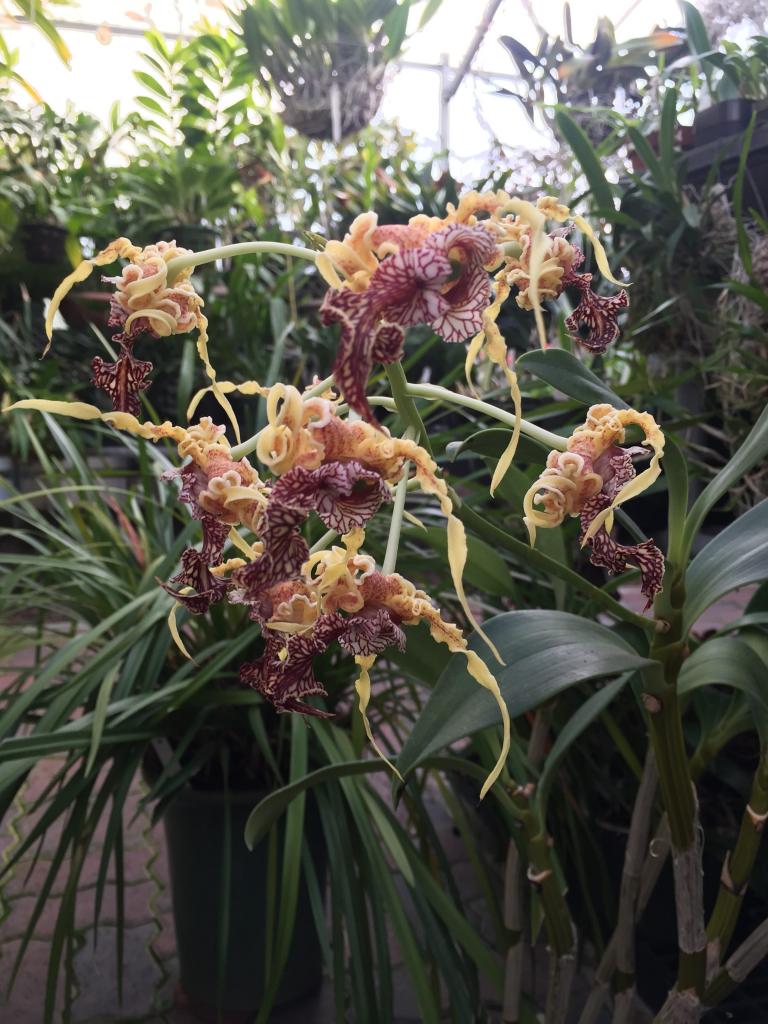

All the most interesting about the orchid for children: description, riddles, facts, tales and legends
New Zealand legend about the origin of the flower
This Orchid Legend for Kids tells about the origin of the orchid according to the Majori tribe - the inhabitants of New Zealand, who believed that the orchid is of divine origin.
“In those days, when people on earth did not yet exist, nature was pure and innocent, this story happened. The bright sun illuminated the peaks of the mountains, covered with snow-white snow.
Under the influence of warm rays, the fluffy veil melted and turned into a stream of seething waters, forming the most beautiful mountain waterfalls, which burst further into the waters of the seas and oceans, then evaporated and turned into curly heavenly clouds.
After some time, the clouds became so many that the sun could not look at the earth. And the sun so wanted it. Heavy pouring rain began. As it passed, a beautiful, enormous rainbow appeared in the sky.
Such immortal spirits that inhabited the earth then saw for the first time. They were delighted, flew from all corners of the earth, and their number increased: everyone wanted to touch the never-before-seen multi-colored bridge across the sky. There was a hustle and bustle everywhere, swearing was heard.
Soon the spirits calmed down, settled into their seats, and began to sing. Unable to withstand the weight, the rainbow caved in and fell to the ground, turning at the same time into millions of small sparks of different colors. The spirits closely watched the multi-colored fountain that spilled onto the ground.
The earth gratefully accepted the rainbow shards. Those that caught the trees turned into orchids. There were more and more of them. Thus began the triumph of the orchid among flowers. "
The Tale of Butterfly Orchids
And this story for children tells about the appearance of orchids, similar to butterflies - phalaenopsis.
“The gaze of the Great Shaman was directed at the carefree and cheerfully playing children. In a forest clearing, children sang songs and laughed. The Great Shaman, on the other hand, was in a bad mood, he was sad, melancholy devoured him. He reflected on the fact that after some time these cheerful children will grow old. All living things (plant, person, animal) grow old and die. Time has no pity for anything or anyone living.
The rainy season was approaching, so it was sad in the thoughts of the Great Shaman. In the meantime, the weather was sunny. The Great Shaman looked around: the clear sky of the tropics overhead, the sun plays with bright reflections on the leaves, which the wind gently lifts up, the mountain peaks sparkle, you can't take your eyes off. In his heart a desire arose to preserve all this beauty, to give it to children, so that their hearts would be filled with joy and happiness.
Taking the magic bag, the Great Shaman went to the forest. There he began to catch multi-colored butterflies.A lot of butterflies got into his bag: their wings were bluish - pink, like the colors of a fading sky, white as a blanket of snow, yellow like autumn leaves, brown like earth, green like an ocean wave. It was not enough for the Shaman; he added the aromas of fragrant herbs and ripe fruits to his bag.


Orchid petals are so similar to the wings of butterflies.
Now the Great Shaman went to the children in the clearing.
“Look what I brought you.” He held out the bag. - Open it, a gift is hidden there.
Read also: What the quince fruit looks like
The children took the magic bag, opened it, letting out a lot of beautiful butterflies. The guys shouted:
- Why did you give us ordinary butterflies? We were expecting a fabulous gift from the Great Shaman!
The Great Shaman felt bitter, he threw his bag on the ground out of resentment, and suddenly the wings of the butterflies froze right in flight, transformed into flower petals, the antennae became processes, all of them turned into flowers of wondrous beauty. They were phalaenopsis, or butterfly orchids. "
The legend of the Japanese orchid
This story happened in ancient times, which many no longer remember. In the land of the rising sun, a small shepherd was sitting on one of the islands in a meadow near the ocean.
He was sad. His job was to graze Mikado goats, which were special.
The boy's sadness was caused by the fact that he would not go the path of a great warrior - a samurai. He looked into the sky and reflected on the eternal questions of the injustice of life, touching his soul.
He thought: why those born in wealth will become warriors, without even wanting to, and the poor, always working and saving money, will still not be able to take this path?
Distracted for a minute from his thoughts, the boy saw two birds in the sky, they were herons. Looking at them, the shepherdess felt good at heart, he watched them until they disappeared from sight. Then he lowered his gaze down to the grass. There he noticed an unusual white flower, so similar to herons hovering in the sky a few minutes ago.
And then the shepherd boy came to understand the truth told to him by Buddha, “everything in this world comes like the flight of these birds, and only beauty is eternal! Look at the flower and remember it! "
So the orchid appeared in the gardens of the Japanese.
Poems
The orchid has always been the focus of literary creativity. At all times, from the moment of her origin, they wrote odes to her, wrote poems, sang songs, composed legends, told tales about her, created statements.
Among the poets are K. Balmont "To the Queen of Fairies", I. Severyanin "Orchid", M. Tsvetaeva "First Journey" and many other authors who convey the splendor of a flower in verse. Prose works or poems, the orchid has always been associated with something unearthly, beautiful, amazing.
Since ancient times BC Orchids live in the world Ideal flowers of Flawless beauty.
Riddles for children
Find a flower of magical beauty Source of light, kindness. Whose magical power will help Bedu to overcome. Her flowers are like fairies, And their name is about ………
She is a flower goddess. The middle name is a heroine, Graceful, like a cypress, And her name is …… ..
Bloom
In the tropics, there is no abrupt change of seasons. The readiness of a plant to bloom is not determined by weather changes, but by the maturity of the orchid itself. Therefore, they do not have a flowering period associated with a particular season. In terms of duration, flowering can last from 8 to 10 months, and sometimes more than a year. The pseudo bulb should be well formed and the leaves should be large. The ripening time of new shoots depends on the genetic characteristics of each type of orchid. It also depends on how artificially created conditions (lighting, temperature, feeding) contribute to the rapid development of young shoots.
Where does the scientific name come from?
The scientific name of the flower is Orchidáceae. Why was it named that way? The very word "Orchid" takes its roots in the ancient Greek language... It comes from the word "orchis", meaning the testicle of a person or animal. According to one of the myths of Ancient Greece, orchid flowers were once the shoes of Aphrodite, the Greek goddess of beauty. Once the shoes of the goddess slipped from her feet, fell to the ground from Olympus and turned into beautiful flowers resembling the shoes of Aphrodite.
What's the other name?
In Chinese, an orchid is denoted by the hieroglyph lan, which also means "shelter" or "closeness." What else is the flower called? For some European peoples, the shape of orchid flowers was once associated with the Catholic cross, which gave rise to the name of the orchid "the flower of the crucifixion."
Signs and superstitions associated with the Phalaenopsis orchid
Over the years, growing in apartments, Orchid has acquired many legends and superstitions. Here is some of them:
- It is a female plant that enhances the attractiveness of the hostess.
- Fights negative energy in the house, protects from the evil eye.
- Strengthens performance, helps fight procrastination.
- Yellow varieties attract money into the house.
Negative superstition is associated with the flower. He is considered a "vampire" and muzhegon. It is not advised to plant a plant for single girls, as well as to put it in any bedrooms, boys' rooms, men's workrooms.
Phalaenopsis family: where they come from
For a long time people believed that orchids grow only in the tropics
, therefore, it is impossible to grow them in an apartment.
Where do they come from? It is difficult to determine the homeland of a flower by any formula, and they do not have a passport. However, it is known that orchids grow in completely different climates
, they are distributed throughout the globe, they are not only in Antarctica.
Most species
yet
prefer areas of rainforest in the tropics
where their delicate flowers are hidden from the direct hit of the sultry rays and are well ventilated.
Some species settle on trees, on stumps, on the ground, while others prefer mountain crevices, where they are protected from drafts. In the process of evolution, they acquired leaves and roots, which help them to preserve life during a drought. As a houseplant, the orchid began to be grown four thousand years ago.
.
Orchids are recognized as a symbol of love and bring harmony to your home.
The orchid is a symbol of love and romance. She is especially popular now
, every housewife wants to have a delicate plant in the house.
How to grow an orchid at home. Prerequisites for growing a home orchid. Phalaenopsis cultivation.
Family
: Orchids (Orchidaceae).
Number of orchid species:
about 40.
Homeland of the orchid
: Southeast Asia.
Description of the phalaenopsis orchid
It is a rosette monopoid plant. In nature, they live in humid areas - on the banks of water bodies or on coastal rocks. They have thick roots of a round or flattened shape, with the help of which plants stick to any surface. The leaves of the orchid are dense, wide, fleshy, dark green, collected in a root rosette.
Phalaenopsis flowers vary in size from 1 to 13 cm in diameter and resemble a butterfly in shape, which is where this name comes from ("phalaenopsis" in Latin means "butterfly"). Inflorescences are located in the axils of the leaves, on one peduncle, depending on the variety, there can be up to 100 flowers. After the flowering of one inflorescence, new ones can develop from the lateral buds. On the peduncles of some varieties of orchids, "babies" are formed, which are easily rooted. The color of flowers can be very diverse, both monochromatic and variegated.
There are two forms of phalaenopsis - standard and miniature. Standard species reach 1 m in height, miniature ones do not exceed 30 cm. They are preferable for keeping indoors.
The flowering time of orchids depends on the species, some of which can bloom three times a year.
Growing an orchid. The necessary conditions
Temperature
The plant is thermophilic, the optimum temperature for phalaenopsis is 22-24 ° C. In autumn, during the laying of flower buds, a temperature decrease to 16 ° C is required for 1-2 months.
Lighting
Orchids prefer diffused light, they cannot stand direct sunlight. It is best to keep them on the east or west windows, but with good artificial lighting, you can put the phalaenopsis in the back of the room.
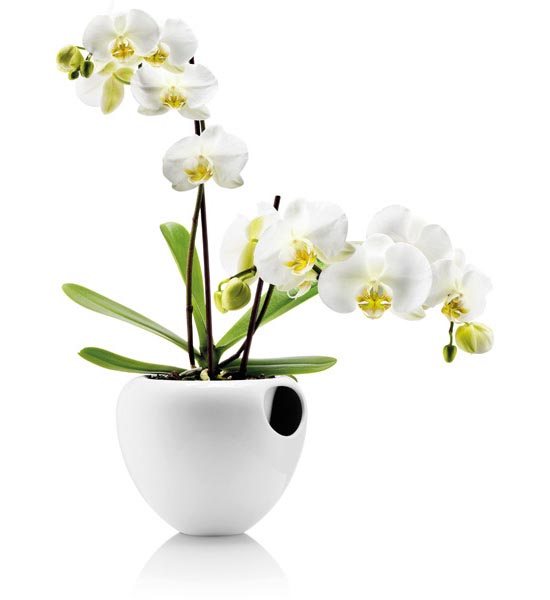

How to properly water an orchid
Phalaenopsis do not like waterlogging - their roots need a lot of air, so watering should be moderate throughout the year. In order to avoid decay of the plant, it is better to water not from above, but from a pallet or by immersing the pot in a container with water. Water for irrigation should be soft.
Fertilizers for orchids
Orchids need regular feeding - in the summer, twice a month at the usual dosage, the rest of the time, once a month with a half dose. For feeding, it is advisable to use a special fertilizer for orchids.
Dormant period
Not expressed.
Air humidity
Orchids are very demanding for high humidity. It must be maintained in all ways - by spraying the leaves and air around the plant, placing the pot on a pallet with wet filler, installing it near a miniature indoor pond (fountain).
When spraying, it should be remembered that water should not be allowed to get on the flowers. In addition, the spray bottle should be the smallest so that moisture forms a misty cloud around the plant, without droplets settling on it.
Orchid transplant
Plants are transplanted every 2 years, in May. In this case, the new container should be slightly larger than the old one. The most important thing when transplanting is not to damage the overgrown fragile roots of phalaenopsis.
The substrate for orchids needs a loose, rough, well-drained medium so that the roots get enough air. So, it can consist of a mixture of coarse sand, sphagnum moss, pieces of pine bark and pieces of charcoal in equal proportions.
Orchid reproduction
"Children" are formed on the stems of the flowers. When they reach a length of about 5 cm, they are separated from the mother plant and rooted in the orchid substrate, immediately planted in a separate pot.
These tropical flowers never cease to amaze. The variety of orchid species makes up 10% of all blooming flora.
Exotics are as tall as a 6-storey building, and live up to 100 years. Some are underground, pollinated by underground insects, others are in the air. Some even know how to copy the smell of bees to lure them to their flowers.
Where did these mysterious creatures originate and where is the birthplace of the orchid plant?
The history of the oldest plant can be traced back to 65 million years
back centuries.
It originated in the tropics of South America. Today it can be found in all corners of the globe, except Africa and the Far North. Prefers a hot, humid climate with long daylight hours.
The name of the flower comes from the Greek for "testicle" because it resembles an egg in shape.
There are more than 30,000 species of orchids
, and their number continues to grow.
Epiphytes
Epiphytes grow by attaching themselves to trees with aerial roots. "Food" is obtained from the environment and the bark of trees and is very fond of sunlight. On their stems there are thickenings resembling nodules. These are false bulbs where the plant stores moisture and nutrients.
Lithophytes
- a similar variety. They settle among stones and rocks, sometimes at an altitude of two thousand meters. In the wild, they are found in the countries of South America, which is officially considered the birthplace of the orchid plant. The roots of lithophytes are similar to the roots of epiphytes. They tolerate cool climates well.
Reproduction
Orchids of different varieties and species can interbreed with each other. Such interspecific hybridization gave the right to life for many beloved and popular varieties. Commonly used orchid farming methods are:
- side shoots, children. They create special conditions for growth, and then they are separated from the stem and transplanted separately;
- air layers, which are also rooted on the mother plant in a greenhouse, and then planted in a separate pot;
- vegetative way, dividing the rhizomes and planting shoots containing pseudobulbs.
The following is a visual video on how an orchid reproduces using root separation:
Orchids are uniquely beautiful flowers that need appropriate conditions... Do not neglect the rules of care and get Asian exotic right at home.
Diseases
The plant can be affected by the disease at any age, most often it can be: • black rot (roots rot, the affected areas turn black). Causes: cold temperature, high humidity. • anthracnose (the whole plant is affected, covered with brown spots and small black dots). The foliage is dying off. The reason is identical with the manifestation of black rot. • Viruses (more than 50 species are known).
With uneven watering, excess sunlight, hypothermia, overfeeding with fertilizers, overheating as a result of excessive sunlight, the use of a large amount of pesticides, an unbalanced diet - your plant may not look very healthy. Balance the care of your pets, take into account the advice of more experienced flower growers, and then your orchids will delight your eyes for a long time with bright colorful moths flying, as if in the air.
Home growing hybrids
When buying phalaenopsis in a large flower shop, many are faced with a choice problem.
Sellers clarifywhat kind of flower you would like to have at home, and begin to list the types.
Let's find out what are the differences hybrid varieties Phalaenopsis orchids:
- Standard is considered the most familiar species for our latitudes. Its height together with peduncles is about 70 cm, hybrid has large dense leaveswhich can reach 35 cm in length. The expelled peduncle during the flowering period has a diameter of 1 cm, on the branches of which flowers of medium diameter are placed. Pot for an adult plant usually no more than 14 cm in diameter;
- Royal phalaenopsis has larger flowers than the standard. And the bole itself, bred using a special technology, has large dimensions. The peduncle grows up to a meter, the leaves can reach 60 cm, and the flower is up to 18 cm in diameter;
- Close in description will be grandiflora... The height of the peduncle in this variety can reach a meter, and the leaf size is up to 40 cm. There are not many flowers on the arrow, up to 10 pieces, but they delight the eye for a long time;
- Phalaenopsis midi have a smaller size, their height reaches only 45 cm with the peduncle, the leaf is no more than 20. The midi subspecies is orchid multiflora, with the same size, it has smaller flowers, which are compactly placed on branched peduncles. On average, this variety can have up to 100 flowers with a diameter of 3-4 cm;
- Mini are different from the rest the miniature size of not only flowers, the stem, together with the peduncle, grows to a maximum of 20 cm. The size of the leaf does not exceed 10 centimeters. The peduncle is low, and the flowers are small, collected in a cap-shaped inflorescence. A distinctive feature of the species is fragility of the whole plant... A pot for him is enough with a diameter of 6 cm;
- Peloric is called a modified flower.who looks different from their relatives. Phalaenopsis with this name differ in colors, which artificially created a more sophisticated shape. There are several varieties of this type, the most common are considered butterflies and biglips;
- Multi-flowered hybrid refers to species of medium height, together with the peduncle, it reaches 55 cm.Most often expels a couple of peduncles, on each of which there are 12-14 flowers reaching 5-7 cm in diameter.
Landing
Getting an exotic plant in a flower shop is simple, it is much more difficult and more interesting to grow it yourself. After all, the seed is much cheaper than the finished flower. Before planting, it is important to decide what you will plant: bulbs or seeds.
The purchase of seeds should be approached with the utmost seriousness.... On Chinese sites that sell them, unscrupulous sellers may forward poor quality products. But even if everything is in order with the seeds, it is almost impossible to grow an orchid from them. This process takes place in a laboratory setting.
With bulbs, everything will be easier. For the bulbous planting method, you should:
- Select a pot... The root system quickly assimilates the prepared space. A regular visual inspection of the orchid is also needed. Based on this, a small pot made of inexpensive transparent plastic is better suited. You don't need to plant the bulbs in clay pots. When transplanting, the plant is quite difficult to extract from them and the only way out is to break an expensive pot.
- Prepare the soil... Choose a special soil for the bulbs. It must contain the following components: bark, peat and coconut fiber, mainly in crushed form.
- Bulb planting procedure... First, we make drainage holes in the selected container. Then fill the pot with a mixture of the substrate and place the onion. Lay out a layer of moss on top. No need to water or spray. After about 2-3 weeks, roots appear.
The following is an illustrative example of planting an orchid in the video:
Description of indoor and wild plants
It is difficult to give a generalized description because they are completely different and are diametrically different from each other.
The stems of the plant are short and long, straight or creeping. Simple leaves are arranged alternately.
Flowers are painted in a wide variety of shades. They make up two types of inflorescences: ear or brush... The flower of most varieties has three sepals at the top and three lower petals. The upper sepals sometimes grow together to form a single organism.
The middle lower petal differs from the rest in its unusual shape, resembling a shoe or a bag. It is called the "lip" and it is often in this petal that the nectary is located. The nectar of some orchid varieties intoxicates insects, which is why they cannot leave the plant and are inside for a long time.


Predatory orchids can lure and intoxicate insects
The pollen grains form hard balls called pollinia. Depending on the type of pollinia, they are softened, waxy, mealy or very hard.... They stick to the insect thanks to the sticky substance. The pollen is collected in such a way as to get completely on the stigma.
Each ovary becomes the progenitor of hundreds of thousands of seeds... Orchid nectar, which attracts insects, has a wide variety of smells, ranging from the unpleasant smell of rotting meat to the scent of elite perfume.
Light and small orchid seeds, ripening in capsules, are quickly carried away by the wind, without even reaching the ground. They fly for a long time, settling on tree branches. Success overtakes those seeds that fall on the mycelium, - only they will give life to a new plant.
There are amazing pollination mechanisms among orchids. For example, plants with a shoe-like structure have an insect trap, some species shoot pollen at pollinators.
Harm and benefit
With all the beauty and splendor, there are mixed reviews about the presence of an orchid in the house... Owners of beautiful flowers are unaware of their benefits and harms.
- Decoctions of orchid flowers help to cope with insomnia, lack of appetite, depression, and diseases of the nervous system.
- In France, the leaves of the plant are added to ice cream.
- The well-known vanilla seasoning is nothing else but an orchid.
- In Mexico, the roots of flowers are used for cooking.
Despite all the positive qualities of an elegant plant, there are a number of contraindications. In nature, there are varieties of orchids that contain poisonous to humans..
- The scent of orchids provokes allergic reactions.
- Frequent migraines.
- The appearance and development of cancer cells.
- A strong odor can lead to dizziness, fainting.
Important! the best place for an orchid is a well-ventilated room where regular air exchange takes place.
You can find out about whether it is possible to keep an orchid at home, whether it is poisonous or not, as well as benefits or harm to the human body, you can find out here.
What price?
The price of blooming orchids in a pot varies from 400 to 3000 rubles... It all depends on the variety, the size of the plant, the place of purchase. For example, in a store near the house, the cost will be higher than in chain hypermarkets, but in gardening farms there is more choice. The average cost in Russia is 700 rubles. Flowers are sold mainly from the Netherlands.
Thai flowers are brought in Russia in sealed transparent bottles. There are 3-5 processes and nutrients for them. But in our climate, orchids do not take root. Such beauties cost 500 baht (900 rubles).
Chinese phalaenopsis orchid seedlings can be purchased online... They are sold in bulk from 100 pcs., The price per unit is from 30 rubles.
Photo
Next, you can see how the flowers of a room orchid look in the photo.
Advantages and disadvantages of a flower
Like any other flower, the orchid has a number of advantages and some disadvantages. The latter are often forced to abandon the idea of growing such flowers at home in a closed system. Of the advantages, it should be noted:
- unusually beautiful large flowers;
- very pleasant aroma;
- long flowering period;
- no need for an annual plant transplant;
- you do not need to water such a plant culture too often;
- problematic plants, in which the leaves began to turn yellow and fall off, can be easily restored.
The main disadvantage of this flower is its exactingness to growing conditions. If mistakes are made, the plant can die quite quickly. Another disadvantage is fragile foliage, which is prone to dropping and discoloration. Orchid leaves are very easily damaged.
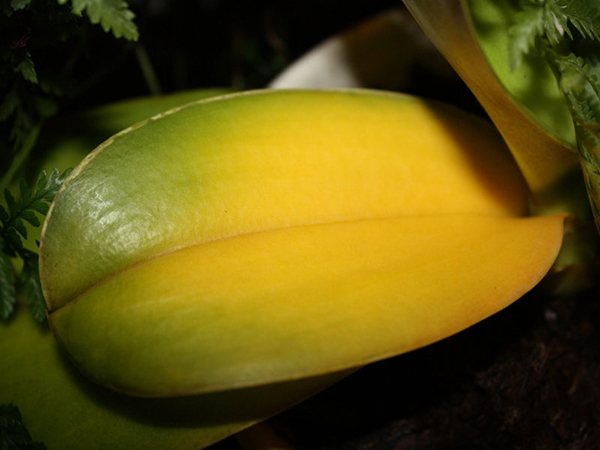

In addition, you should know that orchids tend to rot the root collar and root system. The lower leaves die off quickly with over-or under-watering. Small midges can grow on the plant, which damage the flower.
What similar plants are there?
There are many types of flowers, the shape of which resembles orchid flowers.... So, similar to an orchid, but not:
Night violets


Graceful flowers with elongated petals.
We recommend watching a video about the features of the appearance of the Night Violet:
Schizanthus
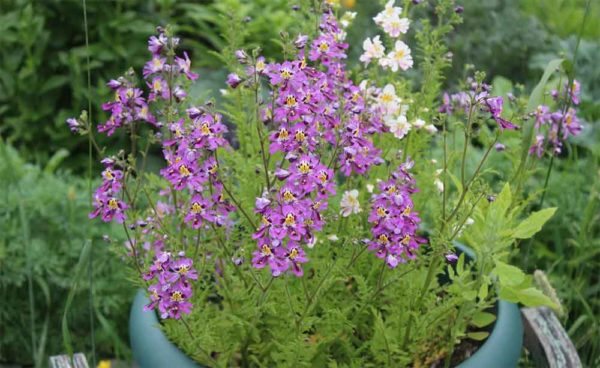

The flowers of which are also similar to those of a potato.
Dracula


A tropical flower with an unusual shape, the appearance of which can evoke associations with the face of monkeys. Dracula is a very unusual and exotic plant.
We recommend watching a video about the features of the Dracula orchid:
How to care for the "queen" of indoor flowers?
Indoor orchid reaches a height of 60-90 centimeters, and a width of 15-20 centimeters. The color is bright and long. The house flower belongs to evergreen plants, its leaves are distinguished by a rich green color. Proper care consists of:
- Observance and creation of the correct humidity. In summer, there is no problem with humidity in residential buildings. In winter, a humidifier will come to your rescue. You can occasionally spray the plant with warm water, this will help moisturize the leaves, and remove such unwanted dust.
- Regular watering. The indoor orchid needs abundant watering, but it is worth remembering about the sense of proportion. The next watering should be done only when the soil is dry. It is better to allow the flower to be saturated with water on its own through the root system.
- Transplanting and feeding the plant.You need to transplant an indoor orchid every year, in the spring. Renewal of the soil and pot allows the root system to "breathe" and be saturated with minerals. It is better to feed the plant with the help of ready-made mineral supplements. But do not "overfeed" the plant, otherwise it has a chance to burn the roots.
- Compliance with the temperature regime. In principle, an indoor orchid, a thermophilic plant. In the summer, you can put the pot on the windowsill, but you should take care that the sun's rays do not come into direct contact with the leaves - otherwise, you will encounter a burn. In winter, beware of drafts and frost.
In severe frosts, the flower must be protected from being on the windowsill. If you strictly adhere to these simple rules, then caring for a room orchid will not be too difficult and confusing, and the hostess will be able to enjoy the long flowering of the plant.

